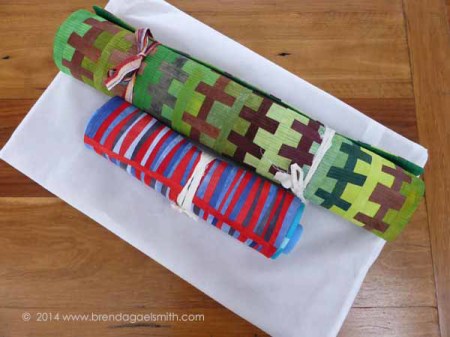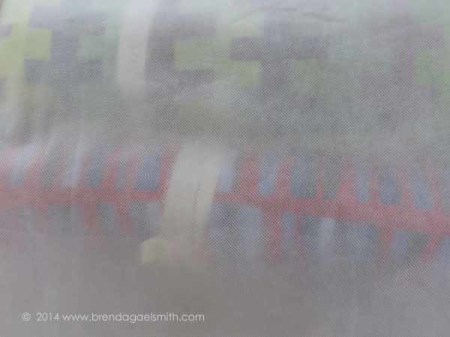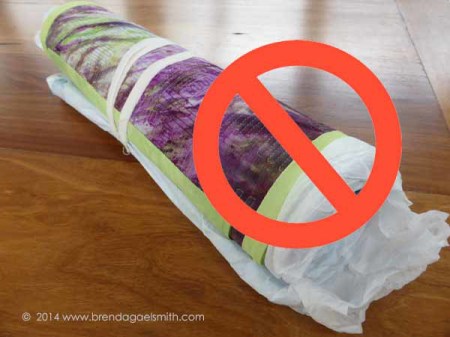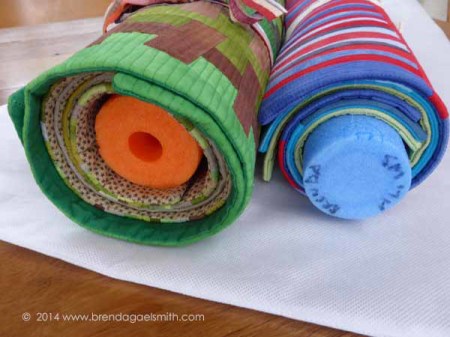One of the highlights of attending the Ozquilt Network conference in Adelaide last month was the opportunity to visit ArtLab Australia. The 50 minute tour included a range of projects such as painting restoration, gilding, photographic and paper works and marble scupture repairs but our primary focus was textiles conservation. Principal Textile Conservator, Kristin Phillips showed us her current assignment, a Chinese silk banner from the Victorian Gold Fields that she is painstakingly stabilising with long, fine polyester threads torn directly from a piece of fabric. We also viewed a vintage crazy quilt and learned about the process of washing textiles – in this case some glorious William Morris curtain fabric. (Sorry no photos.)
The following day, Kristin gave a presentation entitled Stop the Rot: Deterioration in Textiles. The first part of the presentation highlighted some fascinating conservation projects that Kristin has worked on including the comprehensive treatment of the Eureka Flag and the conservation of clothing worn by Indira Gandhi and Rajiv Gandhi at the time of their assassinations that are on dislay at the Indira Gandhi Museum in India. You can hear Kristin talking about these and other projects at: ABC Life Matters Interview with Textile Conservator, Kristin Philips (12 minutes).
The second part of Kristin’s presentation concentrated on practical steps that we can take to optimise the life of our textiles from understanding the implications of our choice of materials and techniques through to exhibition environments and storage methods. Many of us were reassured to learn that it OK ! to wrap our works around polyethlene foam pool noodles for support and there is no need to cover the noodle with tissue paper or fabric first. However, she confirmed that it is best to store rolled textiles with the right side facing out to minimise wrinkles and creasing on the front of the work.
Kristin also emphasised the importance of wrapping textiles in washed calico (or other economical cotton fabric) or tyvek* and checking works regularly for signs of degradation. Wrapping not only protects the work from contact with damaging surfaces (eg acidic cardboard), it prevents light damage while the work is not on display and forms a useful barrier as part of an integrated pest management system.
On a related subject, I have had several people ask me lately about the best way of packing quilts and textiles for shipping. This video from the special exhibits team at Quilts Inc contains lots of useful tips (and a cat!)
I find zipped polyproylene pillow protectors really convenient and economical for packing quilts in for both storage and, with the addition of a large plastic bag available from Chungs, shipping. It’s certainly quicker than making my own! although one day I might try out Terry Grant’s nifty textile travel bag design. (Update: In response to my query, Kristin has advised that “polypropylene is a good stable fibre and will be fine for both long and short term storage”.)
 Another useful feature of the pillow protectors is that they are semi-transparent so you can see the contents without searching for a label/tag or opening up the bag.
Another useful feature of the pillow protectors is that they are semi-transparent so you can see the contents without searching for a label/tag or opening up the bag.
 If you have any practical tips for storing, conserving and shipping textiles, please share!
If you have any practical tips for storing, conserving and shipping textiles, please share!
Products & Suppliers (November 2014)
- Archival Products & Suppliers List published by the Powerhouse Museum Sydney.
- Archival Survival 2014/2015 Catalogue offers tyvek by the roll along with a range of bags, boxes and envelopes.
- Tier Gear offers Tyvek 14M (42gsm, 150cm wide) for A$9.50 per metre.
- Cavalier Art offers heavier weight (but only 914mm) by the metre and by the sheet




Kay Sorensen says
I store my quilts on a bed. It is an odd size antique bed that is never slept in.
I cover the quilts with a sheet when not working with them.
Under the bed we built two “trolleys” that hold smaller quilts.
Almost all the quilts can be stored without folding.
The few that need folding are refolded periodically.
Brenda Gael Smith says
Our guest bed is regularly called into similar service. For example, when I am a collection point for quilts for the Sydney Quilt Show or between exhibitions for Living Colour. I used to use it for my quilts too but then my husband built me a storage room so that we could have visitors again 🙂
Margery says
Lovely storage room; Brenda. And super tidy as well!
Laura Glass says
I stitch white cotton bags for each of my small quilts. When I ship a quilt it’s in the bag, then rolled around a small cardboard tube and then slipped into a large mailing tube with plastic ends. The quilts always arrive safe and wrinkle free.
Brenda Gael Smith says
I envy the tube and box shopping options in North America. Here in Australia, availability is much more limited with Australia Post, for example, only offer three mailing tube sizes that are only suitable for small works.
Lisa says
I was afraid you were going to say that quilts shouldn’t be rolled at all! Thanks for the good information. Rolling them right side out makes perfect sense now that you say why we should do it!
Thank you!
Charlotte Scott says
Some really good info here. I was worried about pool noodles and always wrapped them first. Nice to know about pillow bags for shipping too.
Liz Rose says
How timely, Brenda. I have just bought two gift wrap storage boxes from Aldi to store my smaller quilts (rolled). They are 103 cm x 34 cm x 11.5 cm (height), with a zipper closure and made of polyprop. They will fit under the bed or on the top shelf of a cupboard.
Like many others, big quilts are stored, unfolded, on the spare bed.
Sarah Ann Smith says
In the US (and hopefully elsewhere) you can get archival tyvek which is ideal for conservation/storage. Originally I made sleeves (tubes of muslin/calico) for storing rolled quilts. But I’ve discovered that it is much easier to use a rectangle with ties on one side. After the quilt is rolled (or several on one tube), tuck about 4 inches/10 cm of muslin under the edge of the quilt, then just keep rolling the muslin all the way around. Tie with ties (I take skinny bits of fabric and serge an inch wide strip on the long side).
Also, I’ve FINALLY make some hang tags. These are card stock with a hole in one end and a string. I’ve created a document in Word on the computer set up with two columns, since that size will fit onto the card. I put a thumbnail image of the quilt along with info such as quilt name, date made, size. I print these onto sticky back paper/labels and affix one per quilt onto a hang tag. The tag is pinned to the roll of quilts when the quilt is stored. When a quilt goes out to the show, I then hang the tag on a clip on my magnetic erase-board that tells me where it is so I don’t forget and panic when I can’t find it and don’t remember it has been sent off to an exhibit.
Yep, a bit Type A for sure, and it has taken 15 years to get this organized, but it helps.
Brenda Gael Smith says
Yes, Kristin recommended tyvek as a wrapping material but noted that calico (washed before use) is economical and more readily available. In Australia, the Powerhouse a Museum has published a useful Archival Products & Suppliers List and I see tyvek by the roll is available from Archival Survival ( see page 29 of their 2015/2015 Catalogue). Tyvek 14M (42gsm, 150cm wide) by the metre is also available from Tier Gear for A$9.50 per metre.